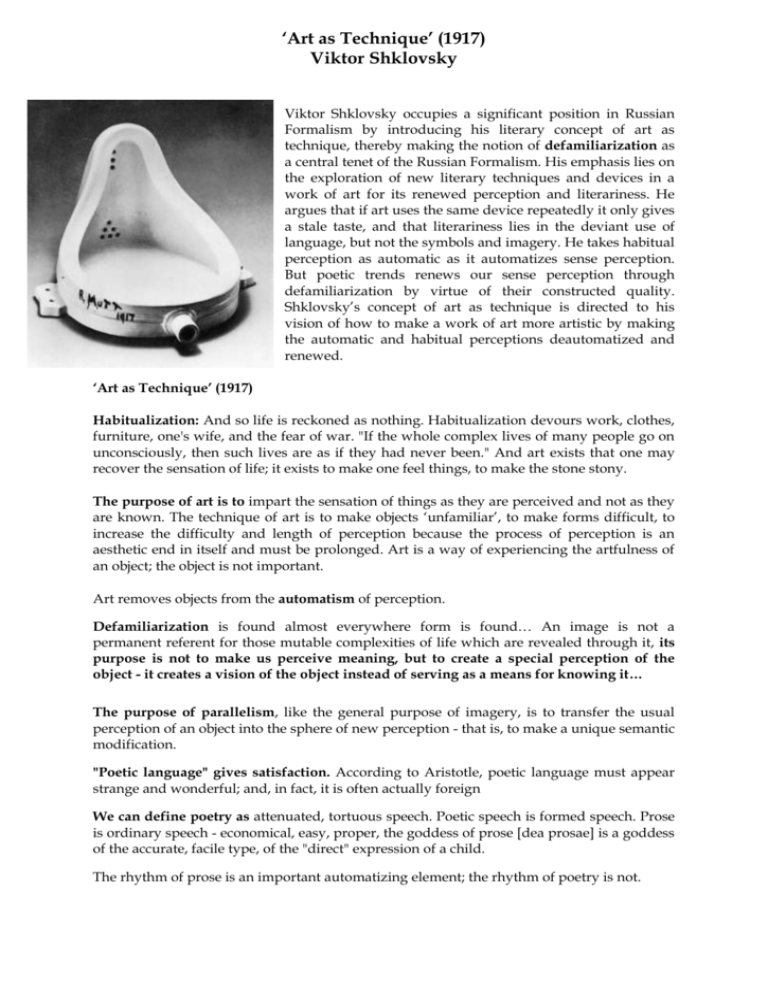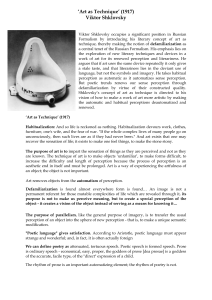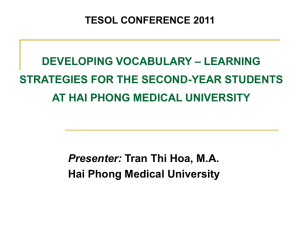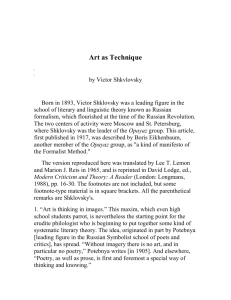`Art as Technique` (1917) Viktor Shklovsky
advertisement

‘Art as Technique’ (1917) Viktor Shklovsky Viktor Shklovsky occupies a significant position in Russian Formalism by introducing his literary concept of art as technique, thereby making the notion of defamiliarization as a central tenet of the Russian Formalism. His emphasis lies on the exploration of new literary techniques and devices in a work of art for its renewed perception and literariness. He argues that if art uses the same device repeatedly it only gives a stale taste, and that literariness lies in the deviant use of language, but not the symbols and imagery. He takes habitual perception as automatic as it automatizes sense perception. But poetic trends renews our sense perception through defamiliarization by virtue of their constructed quality. Shklovsky’s concept of art as technique is directed to his vision of how to make a work of art more artistic by making the automatic and habitual perceptions deautomatized and renewed. ‘Art as Technique’ (1917) Habitualization: And so life is reckoned as nothing. Habitualization devours work, clothes, furniture, one's wife, and the fear of war. "If the whole complex lives of many people go on unconsciously, then such lives are as if they had never been." And art exists that one may recover the sensation of life; it exists to make one feel things, to make the stone stony. The purpose of art is to impart the sensation of things as they are perceived and not as they are known. The technique of art is to make objects ‘unfamiliar’, to make forms difficult, to increase the difficulty and length of perception because the process of perception is an aesthetic end in itself and must be prolonged. Art is a way of experiencing the artfulness of an object; the object is not important. Art removes objects from the automatism of perception. Defamiliarization is found almost everywhere form is found… An image is not a permanent referent for those mutable complexities of life which are revealed through it, its purpose is not to make us perceive meaning, but to create a special perception of the object - it creates a vision of the object instead of serving as a means for knowing it… The purpose of parallelism, like the general purpose of imagery, is to transfer the usual perception of an object into the sphere of new perception - that is, to make a unique semantic modification. "Poetic language" gives satisfaction. According to Aristotle, poetic language must appear strange and wonderful; and, in fact, it is often actually foreign We can define poetry as attenuated, tortuous speech. Poetic speech is formed speech. Prose is ordinary speech - economical, easy, proper, the goddess of prose [dea prosae] is a goddess of the accurate, facile type, of the "direct" expression of a child. The rhythm of prose is an important automatizing element; the rhythm of poetry is not. Lady Gaga Meat Dress Image from 'The Feast of Trimalchio'. Here various ideologies intermingle to make up a strangely disturbing whole. Defamiliarization and Ginsberg a lost battalion of platonic conversationalists jumping down the stoops off fire escapes off windowsills off Empire State out of the moon yacketayakking screaming vomiting whispering facts and memories and anecdotes and eyeball kicks and shocks of hospitals and jails and wars, whole intellects disgorged in total recall for seven days and nights with brilliant eyes, meat for the Synagogue cast on the pavement, who vanished into nowhere Zen New Jersey leaving a trail of ambiguous picture postcards of Atlantic City Hall, suffering Eastern sweats and Tangerian bone-grindings and migraines of China under junk-withdrawal in Newark's bleak furnished room, Questions 1. How does art help us see? 2. How important is it to shock and unsettle the audience / reader? 3. Can art help us to ‘recover the sensation of life’ to ‘make the stone stony’? 4. Can poetry work to defamiliarize us from our surroundings, preconceptions and knowledge of the world? 5. How and why does Ginsberg employ defamiliarization in his Howl? 6. What kind of existence does Ginsberg identify as one defined by habitualised behaviour, habitualised perception and automatism?









